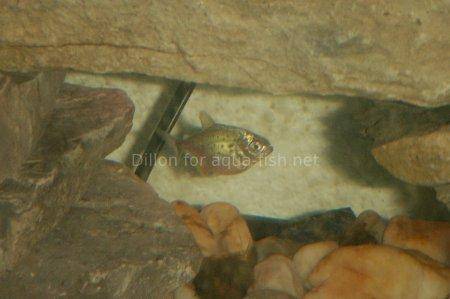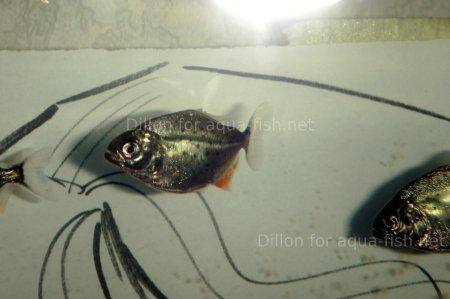Red Belly Piranha - Proper Care, Breeding, Feeding & Forum
Special thanks to Richard Smith for pictures







Quick links - Answers
Brief Description
This article covers all aspects of raising Red bellied piranhas; From diet to tank size and environment, all with large forum under the article! We'd love to hear about your piranhas, so submit your story at the bottom of this page, please! Also visit these pages: Piranha Fish - Information and large forum and Red bellied piranha - Pygocentrus nattereri profile.
Introduction
When someone says piranha, the first thing that comes to mind is often the red churning water over prey that has entered the fish’s territory. It is truly astonishing how a large mammal can turn into nothing in the blink of an eye once it hits piranha infested waters. A vicious fish yes, but just as any other aquarium pet, the piranha species demands extreme care and attention.
Picture of the Red bellied Piranha

The most notorious of the species, the Red Belly Piranha (Pygocentrus nattereri) lives in the wild hunting together in schools that can reach into the thousands. Most people think piranhas only will eat meat, but in the wild they will eat nuts and fruit that fall from nearby trees.
When setting up an aquarium for any fish, the best environment is one that closely mimics the natural setting the fish lives in. Seeing how the Red Belly Piranha (RBP) is from the murky, highly vegetated rivers and streams of South America, dropping him in your old betta tank with a couple marbles at the bottom is not going to cut it.
Aquarium decor
The tank should have a lot of hiding spots made up of driftwood, rocks and vegetation. (Red Bellies are primarily carnivorous so you shouldn’t have problem with keeping live plants.) Not only will this help provide a suitable habitat, but it will also help your tank look natural. Piranhas have a bad fin-nipping habit so providing them with plenty of places to hide will keep your fish looking nice. I’ve seen a few tanks use blackwater extract to give the water a murky feel, but I find that if you provide enough plant shade your RBs will be just fine. Piranhas hate to feel vulnerable, so the main thing is making sure you have plenty of hiding places.
Diet
Seeing as this is the reason why most people buy piranhas, it is important to know what is good and what is unhealthy. Many people assume they can take a steak out of the freezer and drop it in the tank. Excess fat and seasoning is harmful to the fish and their environment. All meat should be fresh and free from any preservatives or anything unnatural. While young, frozen bloodworms are a good healthy choice that will help balance their diet. Goldfish feeders are a favorite but it is a good idea to quarantine them first, due to the higher possibility of diseases and parasites. Some other foods that should be provided to your fish are insects, squid, shrimp, cockles, and mussels.
Filtration
One of the most overlooked problems in a Piranha tank is bad filtration. Their high protein diet makes them a very messy fish. The easiest way I find to resolve this problem is to double whatever your tank is rated for, enough so that the water is cycled through in about 20 minutes. A 25% water change per week will do wonders to keep the aquarium looking pristine.
Size
For the first 4-5 months, if properly fed and cared for, RBPs can grow about an inch (2.54 cm) per month. Slowing later, you will see the red breast turn to a deeper red and the lower jaw begin to attain the famous “piranha underbite.” In the aquarium, RBs generally won’t go beyond 10 - 11 inches (25 - 28cm). And it will take a number of years before arriving at this size.
Tank Size
Depending on what size RBPs you are starting out with a 10 gallon (37.85 litre, 8.33 Imperial gallon) tank is only suitable for very juvenile Red Bellies. Most will require at least 30 gallons (113.56 litres, 24.98 Imperial gallons) until about 6 months old or so. In the same way you want to mimic their environment, Red Piranhas live in large schools, so they should be kept in at least groups of at least 6. Which is why it will not be too long before they will outgrow a 30 gallon (113.56 litre, 24.98 Imperial gallon). Your best bet is a 55 gallon (208.20 litre, 45.80 Imperial gallon), because it will take a few years before the fish will grow too large for an aquarium this size.
Breeding
Highly difficult, leave it to an experienced breeder.
Behaviour
Red Bellies are known to be skittish fish, but I can guarantee you with the proper habitat they will not be so shy. In my tank the piranhas will swim to the front when I approach for dinner-time. In the wild you can find them lurking in the thick foliage along the river beds waiting for prey to come by. If your tank doesn’t provide any place to hide your piranhas can develop an even more skittish behaviour.
This is truly an amazing species. Too often people buy them solely because of their eating habits. If you are buying this fish just for a dinner-time show, go watch the Discovery Channel. If you are looking for an opportunity to care after and learn the habits of one the few pack hunting species of fish, you can’t go wrong with the Red Belly Piranha.


